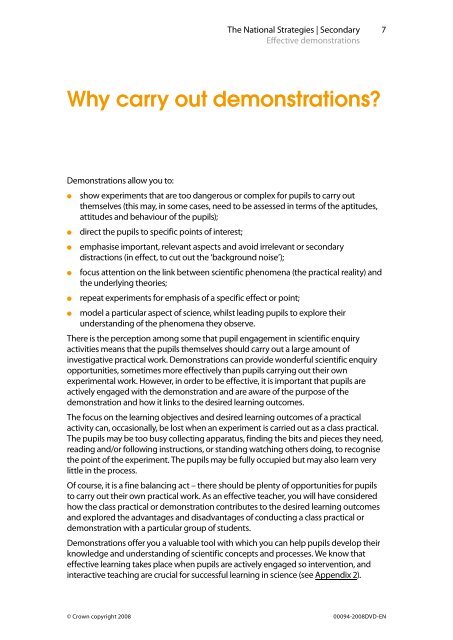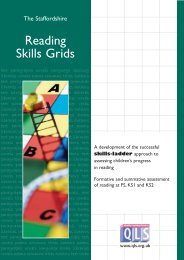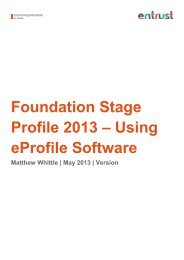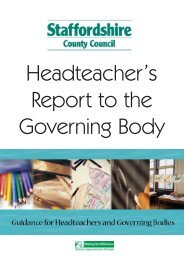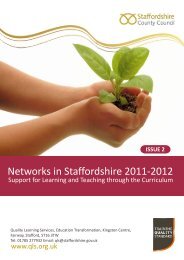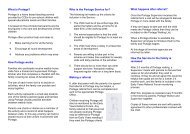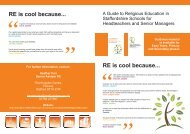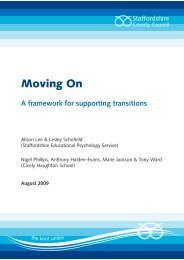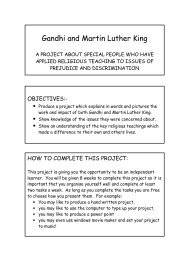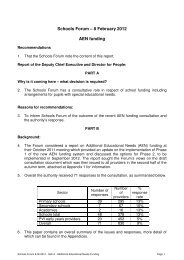Effective demonstrations booklet (401 KB) - Staffordshire Learning Net
Effective demonstrations booklet (401 KB) - Staffordshire Learning Net
Effective demonstrations booklet (401 KB) - Staffordshire Learning Net
Create successful ePaper yourself
Turn your PDF publications into a flip-book with our unique Google optimized e-Paper software.
© Crown copyright 2008<br />
The National Strategies | Secondary<br />
<strong>Effective</strong> <strong>demonstrations</strong><br />
Why carry out <strong>demonstrations</strong>?<br />
Demonstrations allow you to:<br />
● show experiments that are too dangerous or complex for pupils to carry out<br />
themselves (this may, in some cases, need to be assessed in terms of the aptitudes,<br />
attitudes and behaviour of the pupils);<br />
● direct the pupils to specific points of interest;<br />
● emphasise important, relevant aspects and avoid irrelevant or secondary<br />
distractions (in effect, to cut out the ‘background noise’);<br />
● focus attention on the link between scientific phenomena (the practical reality) and<br />
the underlying theories;<br />
● repeat experiments for emphasis of a specific effect or point;<br />
● model a particular aspect of science, whilst leading pupils to explore their<br />
understanding of the phenomena they observe.<br />
There is the perception among some that pupil engagement in scientific enquiry<br />
activities means that the pupils themselves should carry out a large amount of<br />
investigative practical work. Demonstrations can provide wonderful scientific enquiry<br />
opportunities, sometimes more effectively than pupils carrying out their own<br />
experimental work. However, in order to be effective, it is important that pupils are<br />
actively engaged with the demonstration and are aware of the purpose of the<br />
demonstration and how it links to the desired learning outcomes.<br />
The focus on the learning objectives and desired learning outcomes of a practical<br />
activity can, occasionally, be lost when an experiment is carried out as a class practical.<br />
The pupils may be too busy collecting apparatus, finding the bits and pieces they need,<br />
reading and/or following instructions, or standing watching others doing, to recognise<br />
the point of the experiment. The pupils may be fully occupied but may also learn very<br />
little in the process.<br />
Of course, it is a fine balancing act – there should be plenty of opportunities for pupils<br />
to carry out their own practical work. As an effective teacher, you will have considered<br />
how the class practical or demonstration contributes to the desired learning outcomes<br />
and explored the advantages and disadvantages of conducting a class practical or<br />
demonstration with a particular group of students.<br />
Demonstrations offer you a valuable tool with which you can help pupils develop their<br />
knowledge and understanding of scientific concepts and processes. We know that<br />
effective learning takes place when pupils are actively engaged so intervention, and<br />
interactive teaching are crucial for successful learning in science (see Appendix 2).<br />
7<br />
00094-2008DVD-EN


